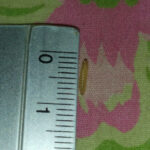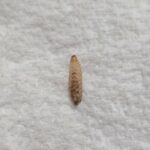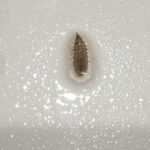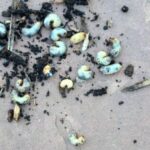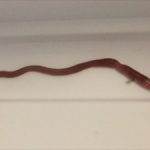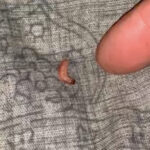
“I’m a wildlife carer and currently have two baby noisy miners. Today I found the photographed larvae (?) in their nest”, writes Lee in her submission regarding the translucent creature with dark entrails pictured below. “Was hoping to find out what it is.” For context for our other readers, a noisy miner is a type of bird endemic to Australia. It is very pretty, with grey, white, and yellow markings, and is named after its noisy nature. From the photo alone, we are not sure what these creatures are that Lee found, though we do agree that they are probably larvae of some kind, given their shape and general physical appearance.
The translucent body and dark entrails reminds us of a flea larva, which would make sense. They have been known to go into birds’ nests to feed on stray feathers, faeces, and other discarded organic debris. To be clear, flea larvae are not like their adult counterparts: they do not feed on the blood of host animals, but instead scavenge for dead organic materials to eat. With all of that said, this still does not resemble a flea larva well enough to have us convinced that it is one. Alternatively, we think it could be some type of beetle larva, as there are quite a lot of clear-white beetle larvae with visible entrails. Unfortunately, that description applies to so many species of beetle larvae that it does not narrow the list down to a list we could realistically pull suggestions from.
In any case, we think it is possible that the larva ended up there because the mother bird brought it there to feed her babies. Equally, it could have hatched from an egg that was on something else brought into the nest. Or maybe it is just a curious larva of some kind that ended up here by accident. Or it is a creature that has a similar diet to the flea larva and was scavenging for food. The other alternative we can think of is that Lee is concerned that these larvae are parasites, or at least some kind of organism that is harming the noisy miners. If Lee is concerned about this, we recommend she take the birds to the vet. We cannot identify such organisms or give advice on how to handle them, because we are not medical professionals. Only a vet can identify if the presence of these larvae is a problem or not, at least in terms of their relationship to the health of the baby birds.
To conclude, we are not quite sure what these larvae are. Our best guess is that they are some type of beetle larvae that ended up in the nest because a baby miner brought it there, or it ended up there of its own accord either by accident or because it was looking for food. If Lee is concerned that the larvae could harm/are harming her noisy miners, we suggest she take the birds (as well as the larvae themselves) to the vet. We hope this helps, and we wish Lee the best.
All About Worms is always free, always reader-supported. Your tips via CashApp, Venmo, or Paypal are appreciated! Receipts will come from ISIPP Publishing.
You might also find these guys interesting!




